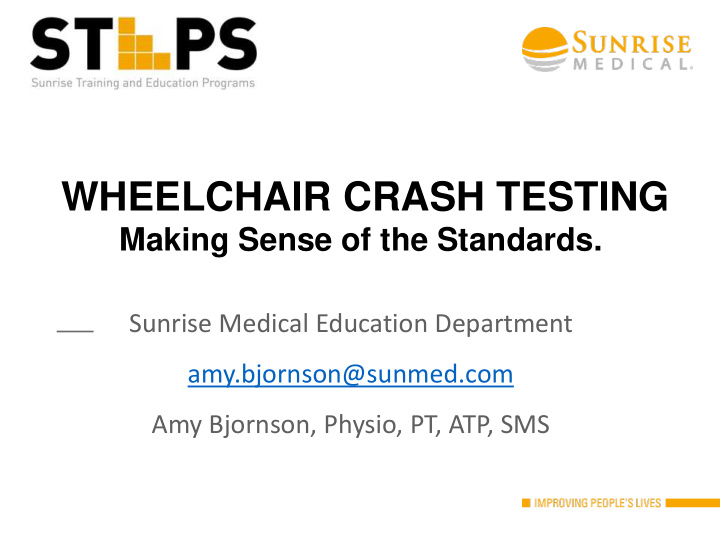



WHEELCHAIR CRASH TESTING Making Sense of the Standards. Sunrise Medical Education Department amy.bjornson@sunmed.com Amy Bjornson, Physio, PT, ATP, SMS
FUNDAMENTALS The vehicle seat offers the highest level of safety as it is secured to the chassis and is designed for this purpose 1. It is recommended that the person is transferred to a vehicle seat, whenever possible. 2. If a person must be transported in a vehicle while sitting in a wheelchair, because it is not possible to transfer, then the following must be noted: The wheelchair must be tested in accordance with ISO 7176-19 or WC-19 and ISO 10542 Wheelchair Tie-Down and Occupant Restraint System. (WTORS) 2
WHAT IS A CRASH TEST? The wheelchair crash test was derived from the crash test already used in the car industry. Wheelchairs are put thru a simulated “crash test” with a speed of 48 kph and an impact deceleration of 20 g’s ISO 7176-19 applies to children and adults with a mass of at least 22 kg (48 lbs.) WC19 applies to wheelchairs designed for children with a mass of 12 kg (26 lbs) or more. 3
WHAT IS A CRASH TEST? 4
STROLLER A wheelchair that is designed for children must provide “ wheelchair-anchored five-point harness” WC19 wheelchair that is rated for occupants from 15 kg to 50 kg must provide both a five-point harness and a wheelchair-anchored pelvic belt. ISO 7176-19 does not include this requirement.” 5
5 POINT HARNESS 6
WHAT IS A CRASH TEST Simulation of a frontal impact and represents a fictitious laboratory test Only front impact Under strict lab environment Vehicle seat offers the highest level of safety 7
8
WHAT DOES IT MEAN TO “HAVE CRASH TEST CERTIFICATION”? Two components: Wheelchair securement • 4-point wheelchair tie-down system Occupant Restraint • 3-point personal restraint system 9
VEHICLE RESTRAINT Australia acknowledges vehicle restraint two standards ISO 7671-19 - Europe WC19 - US 4-point wheelchair tie-down system for all standard wheelchairs, a 6-point system for heavy power chairs, (ISO) 10
VEHICLE RESTRAINT 11
WHAT IS A CRASH TEST? The wheelchair and user must be positioned in the direction of travel and in the axis of symmetry above the securement rails in the vehicle All removable and loose parts must be removed and stowed safely • Trays, crutches • O2, IV poles The wheel locks of the wheelchair are to be applied. 12
ONLY FORWARD FACING 13
APPLYING THE STRAPS Hook labels indicate the position of the securement points on the wheelchair. Fit the front straps on the wheelchair first Then fit the rear straps under tension. 14
WC19 SECUREMENT POINTS WTORS SECUREMENT POINTS The WC-19 Transit System includes four factory-installed transport brackets and a wheelchair anchored pelvic belt system. 15
ISO 7176 SECUREMENT POINTS 16
STRAP PLACEMENT 17
CLEAR ZONES 26” 18
RESTRICTIONS Chair must be forward facing Tilt chairs are tested in HOME position Chairs with seat slope should have less than 10 degrees Back recline should be limited to no more than 30° to the vertical 19
OCCUPANT RESTRAINT ISO 10542 3-point personal restraint system 20
OCCUPANT RESTRAINT Both lap belt and upper torso restraint belt must be used to restrain the wheelchair occupant Postural pelvic belts, harnesses should not be used or relied on for occupant restraint in a moving vehicle unless they are labelled as meeting the requirements 21
APPLYING THE PERSONAL RESTRAINTS After the wheelchair is firmly attached to the vehicle floor add the personal restraints Check for: Fitted securely Not twisted Not passing thru wheelchair components Not obstructed by wheelchair components Upper Torso belt passes over the shoulder - not the neck Pelvic belt is over lower pelvis and tight 22
23
OCCUPANT RESTRAINTS 24
25
Both torso and pelvic belts are used to prevent impact with vehicle components Cannot wrap around wheelchair components 26
STRAP PLACEMENT 27
HEADRESTS The headrest must be at least as high as the centre of gravity of the head, ~9 cm below the top edge. The gap behind the head should be as small as possible. If gap > 10 cm: increased risk of severe whiplash in an accident . 28
WARNINGS Visually inspect all restraint equipment at least once per month – any worn or broken components replaced. Restraints need to be replaced if there is a collision. Release buckles of the belt should be away from items that could inadvertently release them 29
TAKE HOME MESSAGE 1)Use a standard vehicle seat wherever possible, only if not reasonably practical to transfer consider travel in wheelchair 2)Crash tested chair wherever possible 3)Use properly secured approved restraints that are correctly fitted consistent with AS 10542 4)Headrest is important 30
WC18 WC18 requires crashworthiness evaluation of WTORS for general use in all types and sizes of motor vehicles by conducting a nominally worst-case 48 kph (30 mph) frontal sled-impact test using an 85 kg surrogate wheelchair and a midsize adult male anthropomorphic test device (ATD 78) to dynamically load the wheelchair tiedown and occupant restraint system, respectively. 31
WC 20 Seeks to evaluate wheelchair seating systems independent of wheelchair frame • surrogate wheelchair frame (SWCF) • simulated 48 kph frontal crash 32
The University of Transportation Research Institute (UMTRI) lists crash tested : http://wc-transportation- safety.umtri.umich.edu/crash-tested- product-lists/wheelchairs. 33
Thanks for Attending Sunrise Medical Education Department amy.bjornson@sunmed.com Amy Bjornson, Physio, PT, ATP, SMS
Recommend
More recommend